(RETURN)
SAIL VOLUME i
2.
AMERICAN-BUILT CLIPPER
SHIPS
FLYING CLOUD
(1851-1874), 1782 tons , length 225ft,. beam 40ft 8ins.
Constructed of soft wood
and built and designed by Donald McKay at his East
Boston
yard. Purchased by the Grinnell, Minturn & Co,
she made a
record breaking maiden voyage to San Francisco from New York around
Cape Horn in 89days
21 hours - clocking a daily average of of 222
statute miles. She then crossed the Pacific to get
a return
cargo of tea and back to New York. She made
six voyages
of this pattern in which it emerged that she
was extremely
fast in
good winds but relatively slow in the light winds. In the depression of
1856/57, she
was laid up at New York for two and a
half
years. She was sold, and sent to London in December 1859
from
where she made a voyage to China and back.
She then made
a voyage to Melbourne in 85 days,
then to China and back to London. She
was up for sale again and in 1863 the vessel was
purchased by
James Baines of Liverpool to carry emigrants to
Queensland. In the early 1870's she was sold
again.
In 1874 she
was stranded on the coast of New Brunswick and
caught fire while under repairs. Like all
of the softwood
sailing ships her performance
fell off after five years as the timber soaked with water
and was
strained.
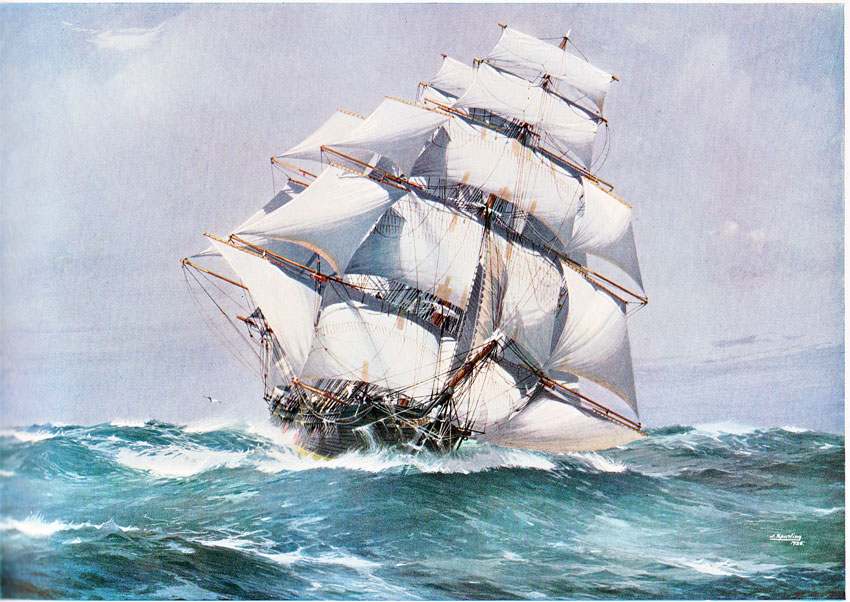
SOVEREIGN OF THE
SEAS (1852 - 1859), 2421 tons burthen (American register),
length 265ft,
beam 44ft.. Of
soft wood construction,she
was built on spec by Donald
McKay at his
East Bosto yard.
His aim was to build a vessel that could
out perform FLYING CLOUD and her spar plan was a size
larger
than
any previous clipper. Her maiden voyage to San Francisco was a success
and she
returned
with a cargo sperm oil from Honolulu. Her next
voyage with
Donald McKay on board was to Liverpool
and this was accomplished from the Newfoundland
Banks in 5 days 17 hours - beating a Cunard
steamship in the process.
In September 1853 she sailed for Melbourne which she
reached in
77 days.
Her return journey with a consignment of gold-dust
and problems with the crew was accomplished in 68
days.
The
vessel was the sold to the Hamburg firm of J.C.Godeffroy & Co.
In her first voyage under
her new owners to Shanghai
she stuck on
the bar and had to be lightened and on her retur journey
cholera affected nearly half her crew In
1859, on the
outward
voyage to China she ran on to the Pyramid
shoals at the south-east.end
of the Straits of Malacca and was a total loss.
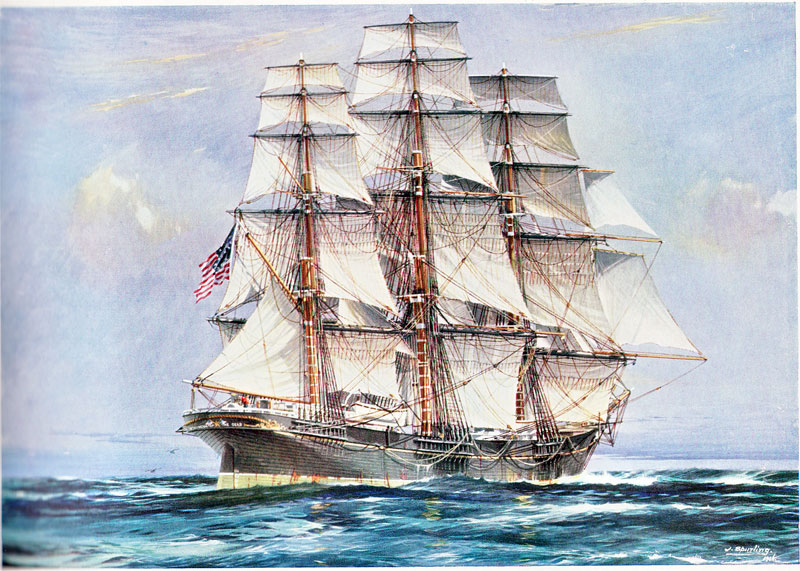
DREADNOUGHT
(1853-1869), 1,400 tons, length 200ft, beam 39f t, depth 26ft. Of
wood
construction,
she was designed designed by Currier &
Townshend at Newburyport,
Massachusetts. She was built for
hard driving in the Atlantic
packet trade and under Captain Samuels
earned the nickname "the
Wild Boat of
the Atlantic". She sailed in the
Atlanti packet
trade for ten years. In 1864, with steamships taking over
the
North Atlantic trade, the ship was put into the
Cape
Horn trade to San Francisco. In 1869, the
ship left
New York
bound for San Francisco. While making for the Straits of
La Maireth the ship got close to the
rocky coast of Tierra del
Fuego.
The wind dropped, the ship lost way and the swell drew her onto
the rocks.
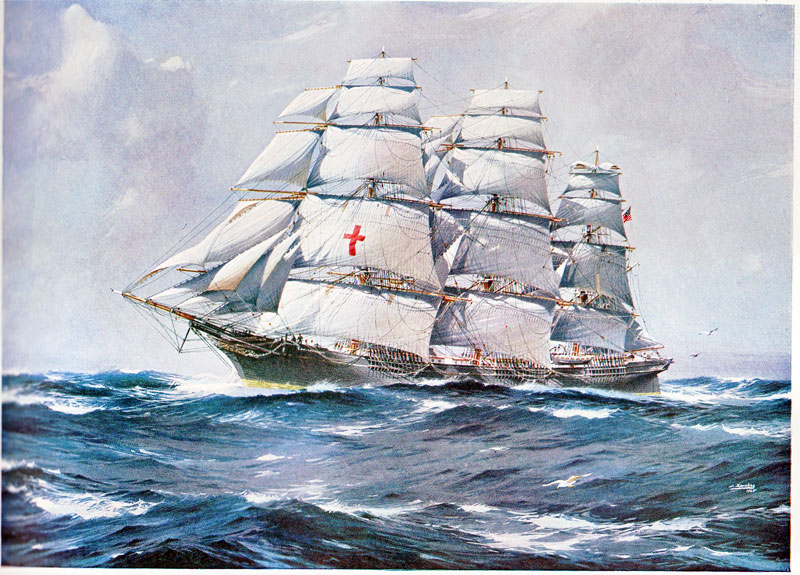
RED JACKET
(1853-1882), 2,305 tons, length overall 260ft, beam 44ft, depth 31ft
Of
softwood
construction, deigned by Samuel A. Pook of Boston
and built by George Taylor
of Rockland,
Maine.
Her first owners were Seacomb & Taylor. The
name Red Jacket came
from the Seneca Chief of the
Wolf Clan who worked
as a scout for the British in the War of Independence and was presented
with
a British
soldier's red jacket. The ship's figurehead was representation of
him. The vessel sailed in early
1854 to Liverpool. The vessel was
chartered
by Pilkington & Wilson's
White Star Line to carry
emigrants to Melbourne - it was the during
the Gold Rush.in Australia. She left Liverpool in May 1854
and
reached Melbourne (Rock
Light to Port Phillip Heads) in 69 days 13 hours 15 minutes. She
had
been under sail for 67 days 13 hours. On her return
she
was bought immediately for the White Star Line.
A rivalry had
also developed with LIGHTNING which had been purchased by James
Baines'
Black
Ball Line. RED JACKET was on the Melbourne run unti
1869..
About 1870, with her hull water
soaked, she was
sold into the Quebec timber trade. In 1882, she became a coal hulk at
Cape Verde.
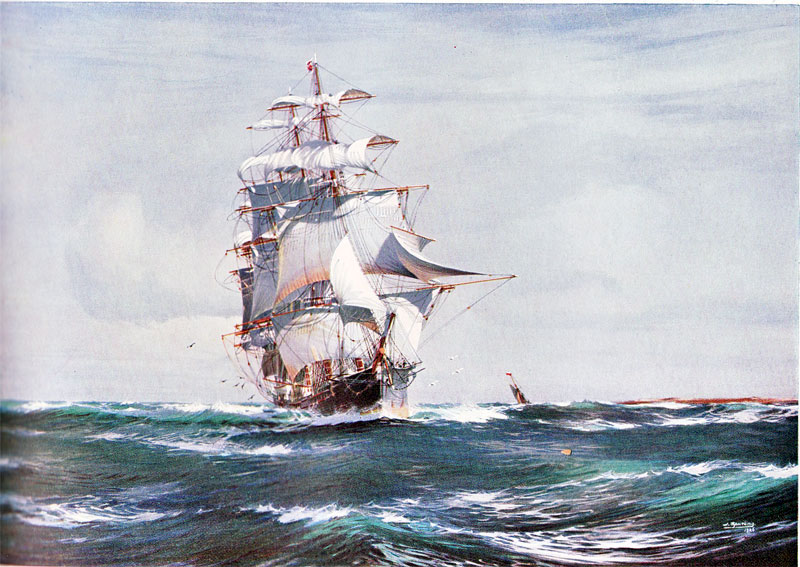
LIGHTNING
(1854-1869), 1,468 tons, length 244 ft, beam44 ft. depth 23ft. Of wood
construction,
designed and built by Donald McKay at his East
Boston yard for James
Baines' Black
Ball
Line. One
of three clippers (LIGHTNING, CHAMPION OF THE SEAS,
and JAMES BAINES) built by
Mckay in
1854and a
fourth
(DONALD MCKAY) in 1855 for the Black Ball Line, LIGHTNING was
of extreme clipper design with
a concave bow. She
was fast:in strong steady wind and twice made 24
hour runs at an average of 18
knots. She was not so good in light airs. Her first five voyages
to
Melbourne were in:
76 days, In 1857 (along with JAMES BAINES and CHAMPION OF
THE SEAS)
she carried troops to India because of the
Mutiny. Subsequently, she made twelve voyages to Melbourne.
In 1869,preparing to leave after loading wool at
Geelong, flames
burst from her fore hold. She was
towed off from
the wharf and eventually scuttled.

JAMES BAINES
(1854 - 1858), 2,275 tons, length 266ft, beam 44ft 9in, depth
29ft. Consructed of
wood, designed and built by Donald McKay, East
Boston.. Slightly
fuller
in design than LIGHTNING.
Her first voyage to Melbourne was
in a record 63 days. In 1857, the JAMES BAINES, LIGHTNING
and many
others carried troops to India following the outbreak of the Mutiny.
She returned with a cargo
of jute, linseed,
rice
and
cow hides. In April 1858, several days after docking in Liverpool
a fire in the
cargo not yet discharged took hold and destroyed
the
vessel..
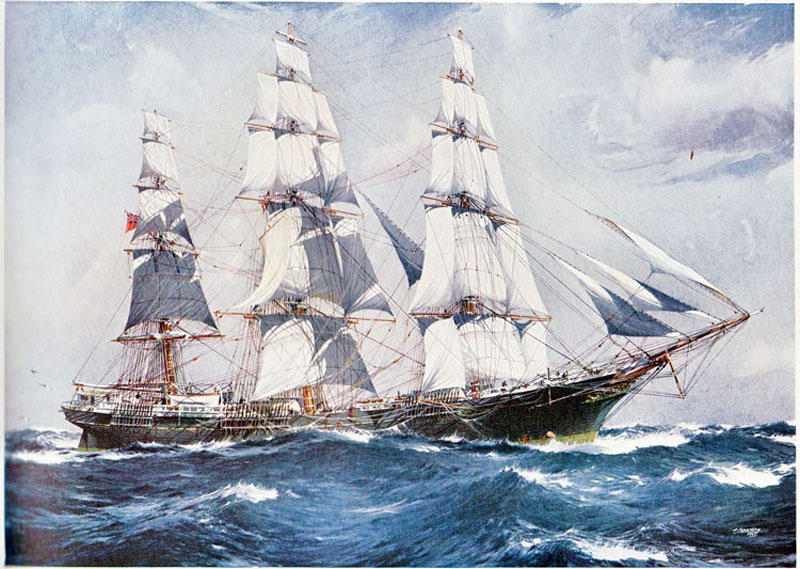
(RETURN)





